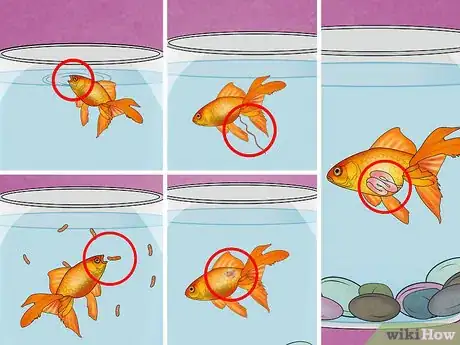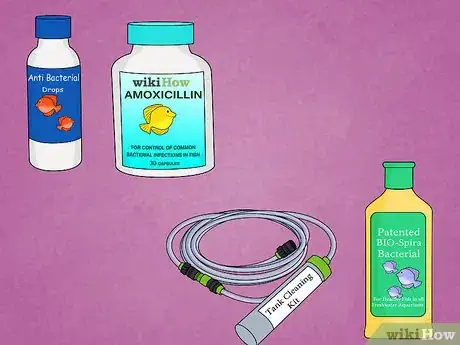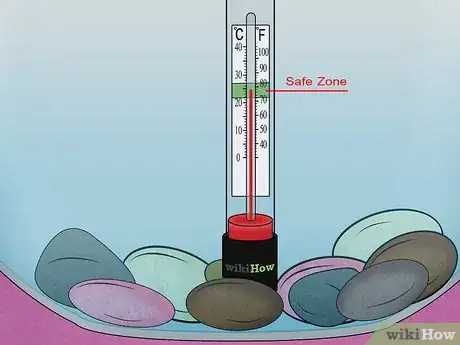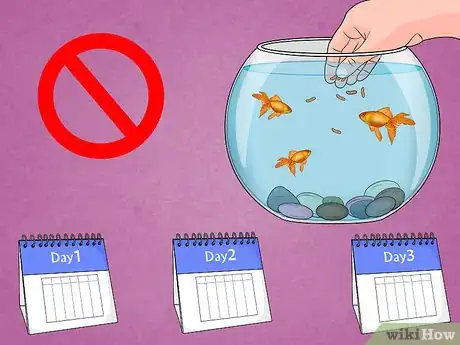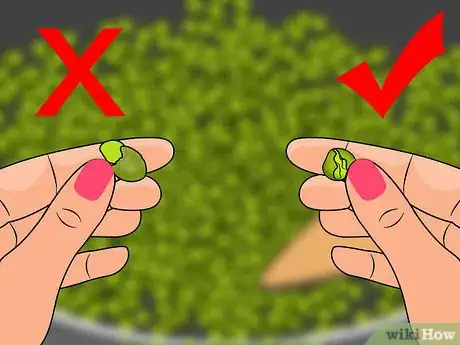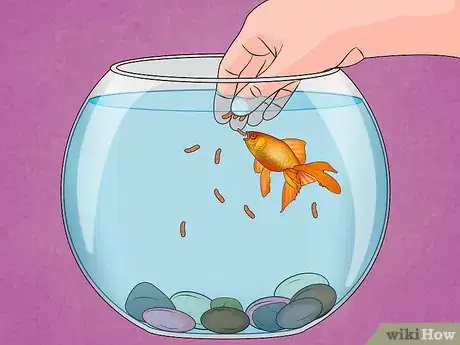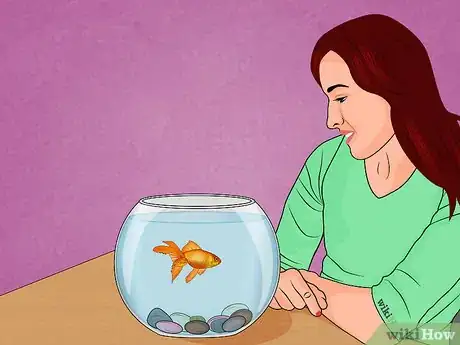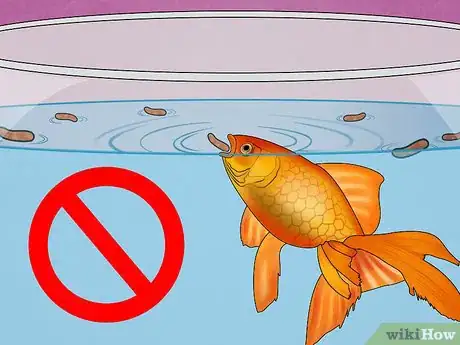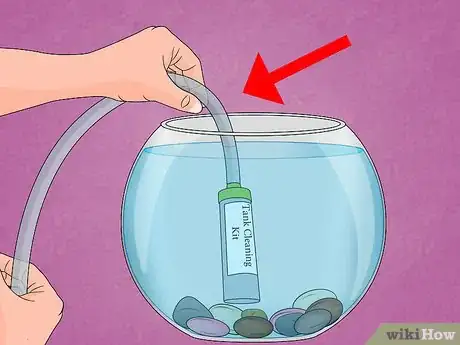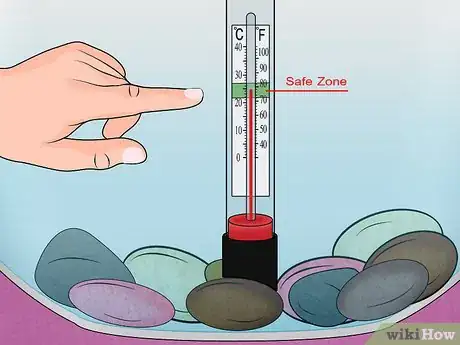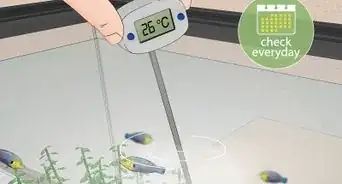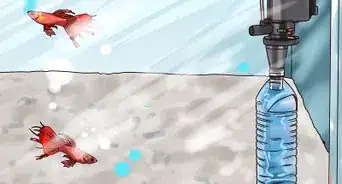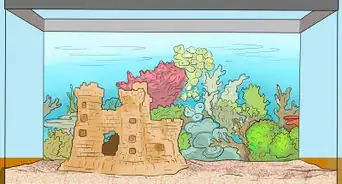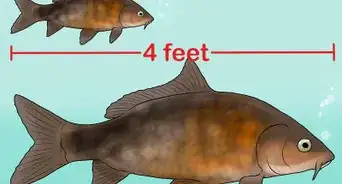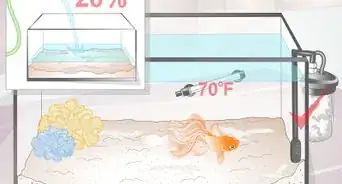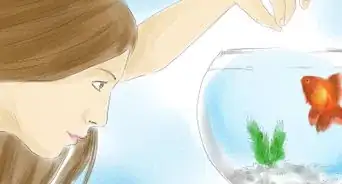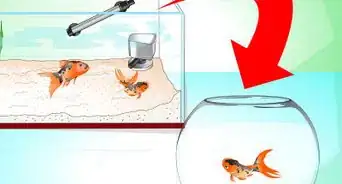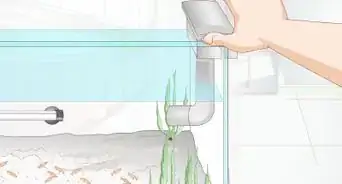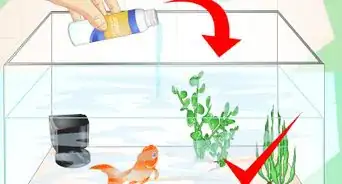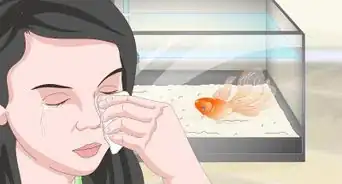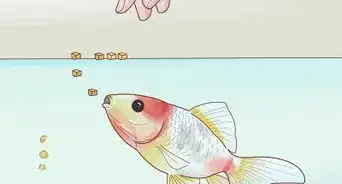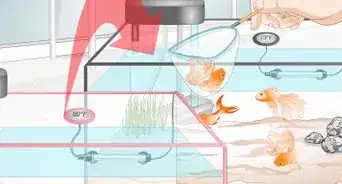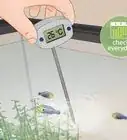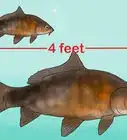This article was co-authored by Craig Morton. Craig Morton is the CEO of Aquarium Doctor Inc. based in Huntington Beach California and servicing Orange County, Los Angeles County, and the Inland Empire. With over 30 years of aquarium experience, Craig specializes in creating custom aquarium designs along with aquarium installation, service, and maintenance.
There are 12 references cited in this article, which can be found at the bottom of the page.
wikiHow marks an article as reader-approved once it receives enough positive feedback. This article received 54 testimonials and 91% of readers who voted found it helpful, earning it our reader-approved status.
This article has been viewed 2,178,112 times.
If your goldfish is swimming sideways or upside-down, it may have swim bladder disorder. Constipation, enlarged organs, or infection can all cause the swim bladder to stop functioning properly. With proper care, you may be able to treat this disease and get your goldfish back to good health.
Steps
Recognizing the Problem
-
1Look for common symptoms of swim bladder disorder. Swim bladder disorder occurs when a fish's swim bladder, which normally inflates and helps the fish stay properly afloat, becomes compromised. No matter what's causing the problem, the symptoms are usually the same. When you see your fish belly-up, don't assume it's dead; if it's still breathing, it probably has swim bladder disorder. Here are symptoms to look for:[1]
- The fish keeps floating to the top, upside-down
- The fish keeps sinking to the bottom of the tank
- The fish swims with its tail higher than its head (note: this is normal for head standing fish species)
- The fish has a swollen belly
-
2Know which fish are most likely to be affected. Goldfish, especially fancy goldfish, and betta fish are most commonly affected by swim bladder disorder. These types of fish have round, short bodies, which causes their organs to become compressed. The fish's internal organs can press against the swim bladder and make it difficult for it to function properly.
- If you have a fancy goldfish or a betta fish, you'll need to monitor it carefully for signs of swim bladder disorder. Left untreated it can lead to death.
- Natural goldfish varieties with longer bodies are less prone to getting swim bladder disorder, since their organs are not packed tightly together.
Advertisement -
3Understand what causes swim bladder disorder. When a fish's tiny organs become enlarged, they can press against the swim bladder and cause it to malfunction. The stomach, intestines and liver are especially prone to becoming enlarged due to the fish's eating habits. Any of the following can cause swim bladder disorder:[2]
- Gulping too much air while eating, causing the stomach to become enlarged
- Eating low quality or air-filled food, causing constipation in the intestine
- Eating too much, causing fatty deposits to enlarge the liver
- The development of cysts in the kidney, causing it to become enlarged
- Deformity of an internal organ
-
4Look for signs of infection. Sometimes swim bladder disorder is a symptom of infection, and you won't be able to solve that by changing your fish's eating habits. If you believe that your fish has an infection, it's important to treat that separately to help your fish get healthy again.[3]
- If your fish has an infection, it will exhibit clamped fins, shaking, and lack of appetite in addition to other symptoms of swim bladder disorder.
- Start by cleaning the tank to reduce bacteria levels; in many cases, this will kill the bacteria causing the infection.
- If symptoms persist, consider treating the fish with a broad spectrum antibiotic to cure the infection. Antibiotics are available at your pet store in the form of water treatment drops or medicated fish food flakes. Be sure to follow the instructions so as not to over medicate your fish.
Treating Swim Bladder Disorder
-
1Raise the water temperature in the tank. A cold water temperature can slow digestion and lead to constipation. While you're treating your goldfish's swim bladder disorder, keep the water temperature between 70 and 80 degrees F to help aid in faster digestion.[4]
- You can use an aquarium heating pad to heat a smaller tank. Use a probe heater for a larger tank.[5]
-
2Let the fish fast for three days. Since swim bladder disorder is commonly caused by eating problems, start by letting your fish fast for three days. When fish overeat they can end up with enlarged internal organs, causing the swim bladder to be compromised. Give the fish a chance to digest the food that it has already eaten and allow its stomach, intestines and other organs to shrink back to normal size.[6]
- Fasting for three days should not negatively affect your fish. However, do not continue the fast for more than three days.
- During the fast, observe your fish to see whether the swim bladder disorder seems to have gone away. If the fish is still exhibiting symptoms, move on to the next step.
-
3Prepare cooked peas for the fish. Peas are high in fiber as well as being dense, so they help ease a fish's constipation problems. Buy a package of frozen peas and cook them until soft (either in the microwave or on the stove). Remove the peel from a pea and drop a bit of pea into the water to feed your fish. The fish should eat no more than a pea or two per day.[7]
- Try not to overcook the peas; if they're too mushy, they'll fall apart before the fish can eat them.
- When fish eat flake food, they often gulp too much air, causing indigestion and organ enlargement. Feeding them dense peas remedies this problem.
-
4Feed the fish by hand if necessary. When you drop a bit of pea into the water, it will be dense enough to sink to the bottom of the tank. Fish with swim bladder disorder may have trouble swimming to the bottom to reach the food. If necessary, hold the pea near the surface of the water until the fish is able to move close enough to eat it.
- You can also skewer a pea on a toothpick and hold it within close range of the fish.
- Lowering the water level so the fish can reach the peas is also effective.
-
5Monitor the fish's symptoms. After a few days on a peas-only diet, the fish's digestion should begin to get back to normal, and you should see it begin swimming without problems again. At this point you can begin feeding the fish regular fish food again.[8]
- If symptoms persist, the fish may have an untreatable problem, such as an organ deformity or internal damage. Give it a few more days to see if the symptoms of swim bladder disorder go away. If your fish never regains the ability to swim and eat properly, euthanasia may be the most humane solution.
Preventing Swim Bladder Disorder
-
1Soak food before feeding. Flaky fish food floats at the top of the water, so when fish take a bite they also gulp down some air. This can cause their organs to become enlarged, leading to swim bladder disorder. Try soaking fish food before adding it to the tank so that it will sink into the water, allowing fish to eat it without taking in air.[9]
- You can also buy sinking fish food that automatically sinks to the bottom of the tank without needing to be soaked.
- If you feed the fish anything besides flakes or pellets, make sure it's nutrient dense and fully thawed before feeding.
-
2Do not over feed. When fish eat too much they can become constipated, leading to intestine or stomach enlargement and swim bladder problems. Fish should only be fed a small amount of food once per day. Even if your fish seems like it's always hungry, it only needs a small amount of food to function healthily.[10]
-
3Keep the tank clean. A dirty tank harbors bacteria and parasites, putting strain on a fish's symptom and sometimes leading to infection. Make sure to change 25% of the water every 2 weeks.[11]
- Use a water test kit to check pH, ammonia, and nitrite levels. Changing the water doesn't guarantee proper levels, especially if you have never tested your water since starting your tank. Goldfish do best with a pH level of 7.2 - 7.6, as little ammonia as possible and a nitrate level of between 0 and .25 ppm.
- Try adding aquarium salt made for freshwater tanks. Aquarium salt is good for helping to fight disease and boosts the goldfish's immune system.
-
4Keep the water temperature appropriately warm. Check the temperature every so often to make sure it is about 70 °F (21 °C). Goldfish don't function well in cold water; keeping them at a lower temperature can strain their systems and slow digestion.[12]
Expert Q&A
Did you know you can get premium answers for this article?
Unlock premium answers by supporting wikiHow
-
QuestionCan you use salt to cure swim bladder disease?
 Craig MortonCraig Morton is the CEO of Aquarium Doctor Inc. based in Huntington Beach California and servicing Orange County, Los Angeles County, and the Inland Empire. With over 30 years of aquarium experience, Craig specializes in creating custom aquarium designs along with aquarium installation, service, and maintenance.
Craig MortonCraig Morton is the CEO of Aquarium Doctor Inc. based in Huntington Beach California and servicing Orange County, Los Angeles County, and the Inland Empire. With over 30 years of aquarium experience, Craig specializes in creating custom aquarium designs along with aquarium installation, service, and maintenance.
Aquarium Specialist, Aquarium Doctor Inc.
-
QuestionMy fish is swimming on a tilt. What is going on?
 Pippa Elliott, MRCVSDr. Elliott, BVMS, MRCVS is a veterinarian with over 30 years of experience in veterinary surgery and companion animal practice. She graduated from the University of Glasgow in 1987 with a degree in veterinary medicine and surgery. She has worked at the same animal clinic in her hometown for over 20 years.
Pippa Elliott, MRCVSDr. Elliott, BVMS, MRCVS is a veterinarian with over 30 years of experience in veterinary surgery and companion animal practice. She graduated from the University of Glasgow in 1987 with a degree in veterinary medicine and surgery. She has worked at the same animal clinic in her hometown for over 20 years.
Veterinarian
-
QuestionShould I feed it frozen peas or cooked peas?
 Pippa Elliott, MRCVSDr. Elliott, BVMS, MRCVS is a veterinarian with over 30 years of experience in veterinary surgery and companion animal practice. She graduated from the University of Glasgow in 1987 with a degree in veterinary medicine and surgery. She has worked at the same animal clinic in her hometown for over 20 years.
Pippa Elliott, MRCVSDr. Elliott, BVMS, MRCVS is a veterinarian with over 30 years of experience in veterinary surgery and companion animal practice. She graduated from the University of Glasgow in 1987 with a degree in veterinary medicine and surgery. She has worked at the same animal clinic in her hometown for over 20 years.
Veterinarian
Warnings
- While it may be tempting to give your fish human food, don't ever give them food that is not part of their normal diet. This will cause indigestion and may even poison your fish.⧼thumbs_response⧽
- Never keep goldfish in bowls due to lack of space and filtration.[13]⧼thumbs_response⧽
References
- ↑ https://www.petmd.com/fish/conditions/respiratory/swim-bladder-disorders-fish
- ↑ https://www.chewy.com/petcentral/what-is-swim-bladder-disease-and-how-is-it-treated
- ↑ https://www.petcoach.co/article/common-aquarium-fish-bacterial-infections-causes-symptoms-a/
- ↑ http://www.fishtanksandponds.co.uk/fish-health/swim-bladder-disorder.html
- ↑ Craig Morton. Aquarium Specialist, Aquarium Doctor Inc.. Expert Interview. 21 July 2020.
- ↑ https://www.smithsonianmag.com/smart-news/dont-get-too-excited-about-viral-goldfish-wheelchair-1-180962571/
- ↑ http://www.petplace.com/article/fish/general/when-your-fish-is-sick/the-goldfish-and-the-pea
- ↑ http://thegab.org/Articles/Buoyancy.html
- ↑ https://kb.rspca.org.au/what-should-i-feed-my-goldfish_457.html
- ↑ https://www.drsfostersmith.com/pic/article.cfm?articleid=1124
- ↑ Craig Morton. Aquarium Specialist, Aquarium Doctor Inc.. Expert Interview. 21 July 2020.
- ↑ https://www.itsafishthing.com/goldfish-water-temperature/
- ↑ http://www.tfhmagazine.com/details/articles/goldfish-myths-debunked.htm
About This Article
If you believe your goldfish has swim bladder disease, raise the water in the tank to 70–80 °F (21–27 °C). The warmer water may help with digestion if constipation is causing the problem. Once you’ve raised the temperature in the tank, don’t feed the fish for 3 days. If your fish still seems to be affected after that, feed it 1-2 cooked green peas a day for several days. The symptoms should subside after that, but if not, your fish may have an untreatable problem, like an organ deformity. Keep reading to learn about the symptoms of swim bladder disease.


